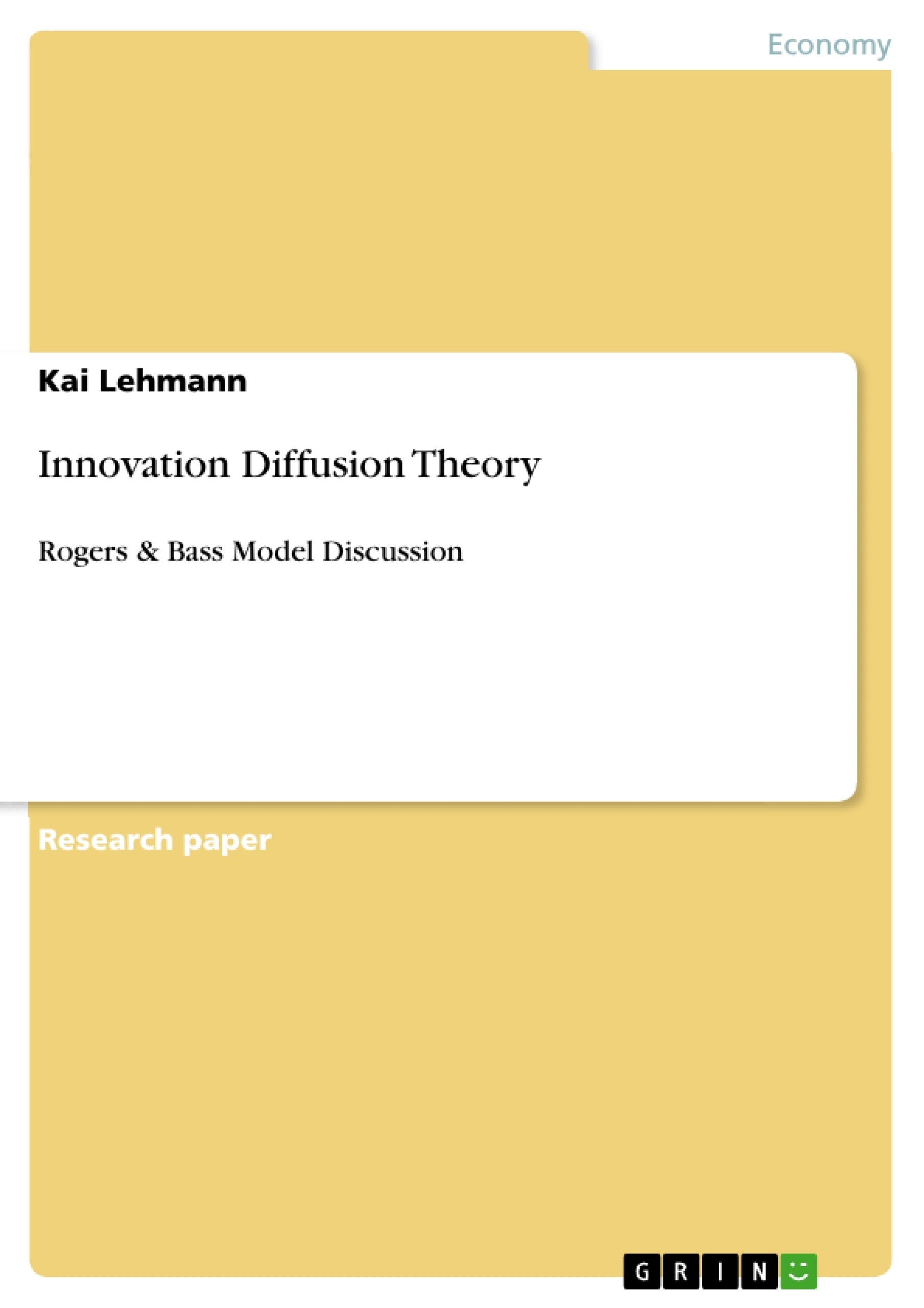One of the most important things in the development of a new product or innovation is to find out the quantitative demand in the future market or focussed social system. How many people will adopt my innovation and how fast is this process? An answer to this question allows to calculate the costs of the innovation forecast and to optimize its specific characteristics. Not at least the knowledge about the innovation diffusion process leads to a better marketing strategy and more sales.
Therefore this assignment tries to take a closer look into the basics of the innovation diffusion theory based on research results by E. M. Rogers (II). The main elements will be specified and its affects on the speed of innovation diffusion will be extracted. Furthermore this work includes a critical description of the mathematical model of innovation diffusion processes developed by F. M. Bass in 1969 (III). Special focus in this part will be the interpretation of the coefficients p an q. At least there is a short summary about the effectiveness of innovation diffusion theory according to Rogers and Bass in face of reality (IV).
Inhaltsverzeichnis (Table of Contents)
- I. Introduction
- II. Innovation Diffusion Process
- A. Defining Innovation
- B. Uncertainty Created by Innovations
- C. Perceived Attributes of Innovations
- D. Communication Channels
- 1. Mass Media Channels
- 2. Interpersonal Channels
- E. Time and Innovation Diffusion
- 1. Innovation Decision Process
- 2. Innovativeness of Individuals and Social Systems
- 3. Rate of Adoption
- F. Social System and Innovation Diffusion
- 1. Social Structures
- 2. Norms and Traditions
- 3. Opinion Leaders and Change Agents
- 4. Type of Innovation Decision
- 5. Consequences of the Innovation Decision
Zielsetzung und Themenschwerpunkte (Objectives and Key Themes)
This work aims to provide an overview of the innovation diffusion theory developed by E. M. Rogers, specifically focusing on the factors influencing the speed of innovation diffusion. The study investigates the key elements of the theory and analyzes the mathematical model developed by F. M. Bass. The work aims to understand how the theory can be applied in practice and its limitations.
- Understanding the core concepts of innovation diffusion theory, particularly as defined by E. M. Rogers.
- Examining the role of perceived attributes, communication channels, and time in the diffusion process.
- Analyzing the mathematical model of innovation diffusion developed by F. M. Bass, including the interpretation of its coefficients.
- Exploring the influence of the social system on innovation diffusion.
- Evaluating the effectiveness of the innovation diffusion theory in practical settings.
Zusammenfassung der Kapitel (Chapter Summaries)
I. Introduction
This chapter introduces the concept of innovation diffusion and its importance in predicting the adoption rate of new products and innovations. The work aims to analyze Rogers's theory and Bass's mathematical model, emphasizing the factors that influence the speed of innovation diffusion.
II. Innovation Diffusion Process
This chapter delves into the core components of the innovation diffusion process, exploring Rogers's definition and analysis of the key elements. It examines the role of perceived attributes, such as relative advantage, compatibility, and complexity, in shaping the adoption decision and the speed of diffusion. The chapter also discusses the importance of communication channels, particularly interpersonal networks and the impact of heterophily on the diffusion process.
The influence of time on innovation diffusion is further examined. The chapter breaks down the innovation decision process into five steps: knowledge, persuasion, decision, implementation, and confirmation. It introduces the concept of innovativeness and its role in categorizing adopters into different groups. The rate of adoption is also explored, emphasizing the importance of the social system in influencing the diffusion process.
Finally, the chapter examines the influence of the social system on innovation diffusion, highlighting the role of social structures, norms, and opinion leaders in shaping the speed of adoption. The type of innovation decision and its consequences within the social system are also discussed, further illustrating the complex interplay of factors affecting innovation diffusion.
Schlüsselwörter (Keywords)
The main keywords and focus topics of this text include innovation diffusion, E. M. Rogers, F. M. Bass, perceived attributes, communication channels, heterophily, time, innovativeness, social system, adoption rate, and change agents. These terms encapsulate the primary concepts and research foci of the work, providing insights into the dynamics of innovation adoption and diffusion within social systems.
- Citation du texte
- Kai Lehmann (Auteur), 2004, Innovation Diffusion Theory, Munich, GRIN Verlag, https://www.grin.com/document/80117



